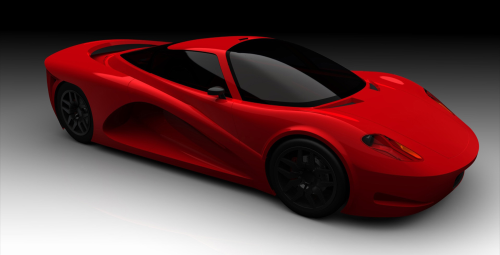
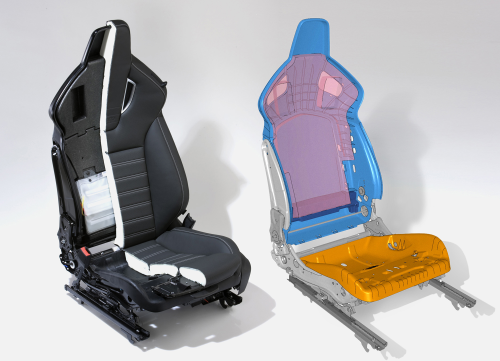
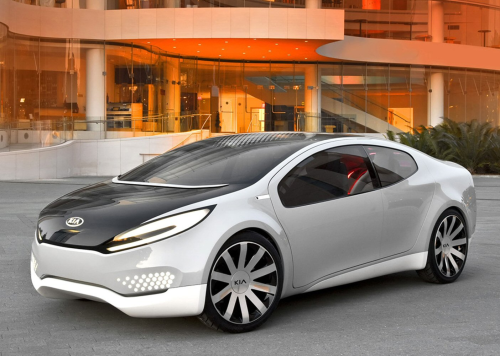
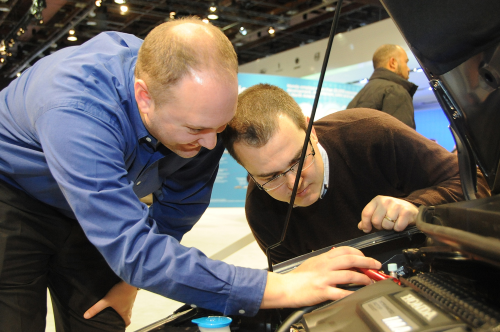
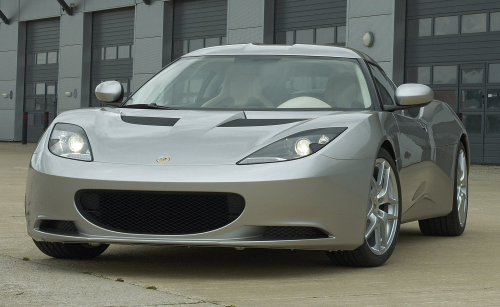

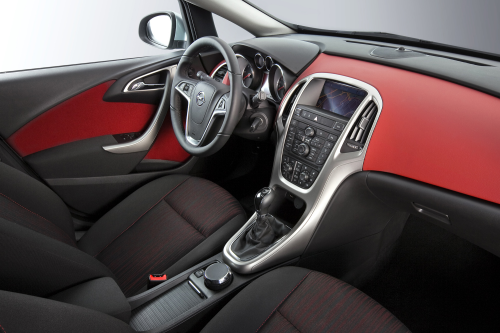
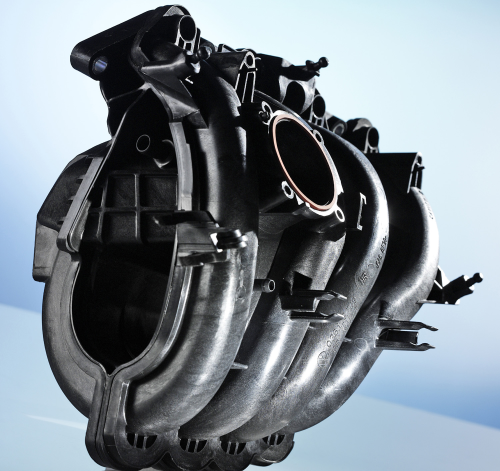
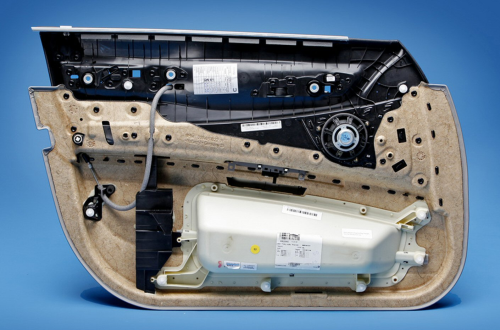
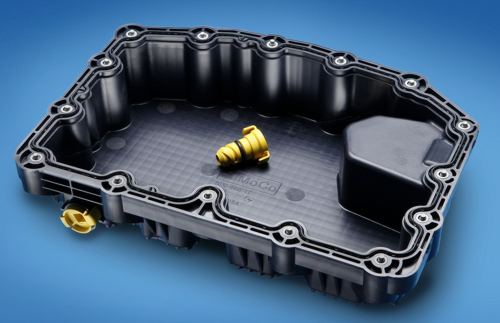
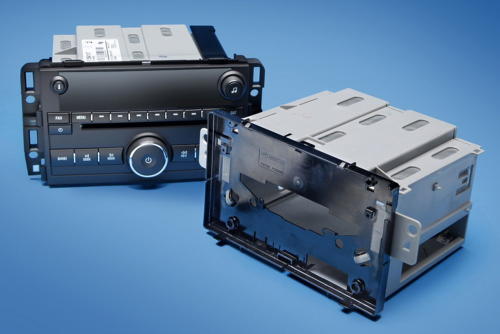
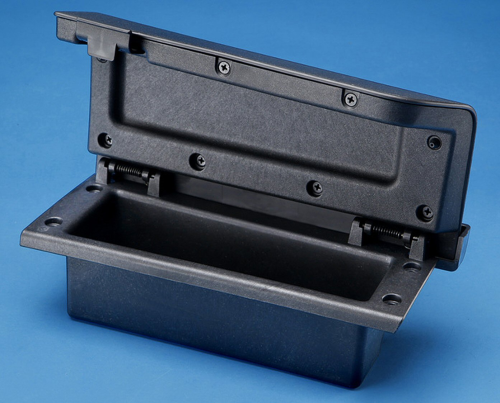
The key to improved fuel efficiency is reduced mass, and original equipment manufacturers (OEMs) are now viewing composite materials more in terms of their lightweighting benefits rather than their cost versus steel and aluminium. Pressured by government demands for higher mileage vehicles and emissions reductions, automakers are warming to innovative solutions and looking at more costly materials such as carbon fibre composites and nanocomposites to achieve needed weight targets. Material suppliers are optimistic about the growth of composites in automotive applications. Cedric Ball of Ashland Performance Materials observes that the automotive industry is experiencing a major shift toward a new generation of vehicles.
“With tremendous pressures to improve fuel economy and lower production costs, we're really in the midst of a ‘perfect storm’ of market pressures and industry trends that make composites more attractive for automakers than ever before." Ball is serving as conference chair of the 2010 Society of Plastics Engineers (SPE) Automotive Composites Conference and Exhibition (ACCE), scheduled for 15-16 September in Troy, Michigan, USA. The theme of this year’s ACCE is Composites: Shaping New Vehicles. Now in its 10th year, the conference has become a leading forum for automotive composites, drawing exhibitors, speakers and attendees from around the world. Creig Bowland, technical leader/research associate in Long Fiber Thermoplastics at PPG Industries, who is planning the ACCE technical programme, feels that the automotive industry needs composites now more than ever before.
“The low build rates and need for fast development of energy-efficient vehicles means that composites are really the solution,” he notes.
Running on electricity
Many see electric and hybrid vehicles as a good route away from dependence on oil and reduced emissions. The 2010 North American International Auto Show, held in Detroit in January, featured some 20 models in an 'Electric Avenue' showcase of electric vehicles and technologies by traditional automakers and independents. Lightweight materials technology is vital to the success of electrics and hybrids to offset the added weight of batteries. But what about storing electrical energy in the composite materials themselves? Not impossible, says Imperial College of London. Researchers at Imperial and their European partners, including Volvo Corp, have developed a prototype carbon fibre composite material that could change the face of hybrid electric vehicles. The patented material, designed to store and discharge electrical energy, is strong and lightweight enough for vehicle structural components and body panels. The car itself could serve as a battery, the researchers believe. The material is said to be capable of storing and discharging large amounts of energy much faster than conventional batteries. The recharging process involves none of the chemical reactions which cause batteries to degrade over time. Among the latest of the electrics to debut is the Ray plug-in hybrid concept, unveiled in February at the 2010 Chicago Auto Show by Kia Motors America. The composites-intensive four seat compact sedan demonstrates a configuration from Kia that features lightweight and recycled materials, as well as solar cells embedded in the glass roof panel. The Ray is designed to reach driving distances of more than 50 miles (80.5 km) on battery power and a total range of 746 miles (1200 km) with the all-aluminium gasoline engine. California car designer Velozzi intends to bring the Velozzi Supercar, a high-performance (0-60 in 3 seconds) electric sports car constructed of carbon fibre and nanotube reinforced composites, to market later this year. A crossover plug-in hybrid vehicle, the Velozzi SOLO, will be available in 2011. The vehicles are the first production cars to be constructed with carbon fibre nanotubes, which are said to significantly increase the mechanical properties and reduce weight of components. Velozzi has teamed with a number of suppliers, including Bayer MaterialScience and Ashland, in developing the vehicles.
Composites leadership
Researchers at global automotive supplier Faurecia have intensified efforts to cut weight from vehicles, reportedly doubling the potential weight savings the company’s products can achieve. The supplier specialises in seats, vehicle interiors, front ends and emissions control technologies. Through the use of natural fibres and other composite and hybrid components, Faurecia believes it can eliminate up to 130 lbs (59 kg) from an automobile by 2020. The supplier is a significant contributor to 16 of the 20 most fuel-efficient vehicles on the world market. “With stricter CAFE requirements coming quickly, automakers will be forced to drastically reduce the weight and emissions of their vehicles without compromising safety, comfort or quality,” observes Mike Heneka, president of Faurecia North America. “These trends and others are driving automakers to partner with suppliers that can accelerate cost effective, innovative product development.” A door module for the Jeep Liberty SUV produced by Faurecia was a finalist in the 39th Annual Innovations Awards Competition, sponsored by the SPE Automotive Division. Faurecia acted both as system supplier and material processor, using a new grade of 32% short-glass-filled polypropylene (PP) from Asahi Kasei Plastics to mould the module. It replaced a more expensive long-fibre grade of PP. The resin, supplied as a pre-coloured, high-glass masterbatch, enables processors to customise glass loading at the press. BMW continues its innovative, award-winning applications of composite materials to save weight and enhance performance. The M-Series carbon fibre roof incorporates Hexcel’s HexForce® NC2® multiaxial reinforcements in the inner structural layer. The Z4 underbody shielding is a layered, sandwich-like core structure made of SymaLITE® from Quadrant Plastics Composites. The award-winning transmission cross beam of the Gran Turismo 550i is made from BASF Ultramid 50% glass reinforced polyamide, replacing aluminum. And recently BMW announced a joint venture with SGL Group for carbon fibre materials to be used it the future Megacity Vehicle. Ford Motor Company, another composites leader, continues breaking new ground in materials to save weight and reduce costs. A new application is an underbody heat shield to insulate the fuel tank from the high temperature of engine exhaust. The component is compression molded of 50% chopped glass reinforced sheet moulding compound (SMC) material formulated with AOC resin. It was specially formulated for structural SMC applications which require higher mechanical properties when exposed to a hot or corrosive environment. Supplier Pilot Automotive, headquartered in Buenos Aires, Argentina, supplies a variety of SMC parts to Ford. Lotus Cars introduced the Exige Scura, its latest special edition high-performance sports car, at the Tokyo International Motorshow in October 2009. Extensive use of carbon fibre composites, finished with clear lacquer, provide weight savings of 10 kg (22 lbs) versus the already lightweight Exige S model, the company reports. A production run of 35 cars is planned for the £45 000 (US$70 442) sports car. The higher volume Lotus Evora (2000 units a year), has been winning accolades from car enthusiast magazines on several continents. Most recently, the BBC's Top Gear magazine named it Sports Car of the Year. The Evora employs lightweight aluminium and composite components, including stressed composite roof and body panels, which contribute to vehicle stiffness.
Metal replacement
DuPont Automotive reports that it is developing engineering plastics and new high-performance composite materials that provide improved function in automotive applications at weight savings of 30-40% over metal components. At the same time, the materials can provide cost savings of 30-50% by integrating separate parts into modules, says DuPont. New materials can withstand heat in the engine compartment up to 260°C (500°F), expanding the possibilities for metal replacement. They also enable moulded-in fittings for fast assembly and better packaging in cramped engine compartments, notes the manufacturer. LANXESS, the German specialty chemical company, reports advances in its family of reinforced semi-crystalline products toward the goal of replacing metal automotive components, including frames and other structural parts. The company offers Durethan® polyamides and Pocan® polyesters with high glass fibre reinforcement levels of 50-60% which can be processed as easily as a general-purpose grade with 30% reinforcement, the company says. The performance front seats of the new Opel Insignia OPC, developed by Opel and Recaro, are produced with two special polyamides belonging to the BASF Ultramid® family as well as Neopolen® expanded PP foam. The seat pan, backrest shell and crossbar were designed using BASF’s ULTRASIM™ simulation package. The glass-reinforced plastic parts eliminate the need for steel frames, which previously were used in the seats. The simulator tool dimensioned and optimised the parts to meet crash requirements.
Automated composites
MAG Industrial Automation Systems has introduced what it calls breakthrough automotive composites technology that “combines the cost and production-rate requirements of the auto industry with the engineered performance of oriented-fibre structures used in the aerospace industry.” Its new Continuous Laminating Line utilises MAG’s continuous-fibre thermoplastic and thermoset prepregs to produce thin-walled, structurally engineered parts that are 40-60% lighter than steel and twice as strong as high-strength SMC, the company relates. Focus has been on optimising the performance of lower-cost reinforcements such as E-glass, although carbon fibres and hybrid prepreg materials can be processed with the machinery, notes MAG. The continuous fibre prepregs developed by the company are said to have a much lower coefficient of variation than SMC, with uniform distribution and orientation of the reinforcement fibres compared to chopped fibres. The line can tailor the reinforcement during layup to meet the engineering requirements of the part, whether it is a structural component or a full, multi-piece underbody component. Based on a modular design for scalability, the Continuous Laminating Line consists of modules which can each hold two rolls of prepreg material up to 80 inches (2.4 m) wide. The system can lay up various widths in a single part, with one module processing full-width material and a second module applying a narrower width. In-line cutting and splicing enable continuous operation as well as placement of cross plies to reinforce transitional areas, such as cross-car stiffeners on a floor pan, MAG explains. Modules for placement of core materials for sandwich structures are also being developed.
Underhood applications
An air-intake manifold system for a 2010 General Motors V6 engine is the first use of high-flow nylon (polyamide) for a structural power train application and the largest nylon part in an automotive application, reports SPE in announcing the part as a finalist in the Innovation Awards competition. The 30% glass-reinforced Akulon® Ultraflow K-FHG6 PA 6 from DSM Engineering Plastics is said to provide 80% higher flow without significant loss of mechanical properties than standard-flow grades. Higher flow facilitates design optimisation, allows for lower injection pressures and produces parts with reduced moulded-in stress, notes SPE. The material also has a faster crystallisation rate, which shortens cooling time and reduces warp and distortion for reduced scrap. A fluid filter module for the 2010 model year Daimler AGT- Mercedes C-Class moulded by Mahle Filter Systems provides 38% weight and 16% cost reductions. The component was a finalist in the SPE Innovation Awards competition. Mahle utilised 35% glass reinforced Durethan AKV PA 66 from LANXESS to produce the component.
|
Winners of the 39th Annual Innovations Awards Competition, sponsored by the Automotive Division of the Society of Plastics Engineers (SPE), were announced in November 2009 at the annual gala held near Detroit. Reinforced plastics played a major role in the production of many of the winning entries and finalists. More than 50 components were nominated. In the Materials category, the Innovation Award winner went to a compression molded door panel for the BMW 7 Series sedan. It was produced by the Dräxlmaier Group using a unique thermosetting acrylic copolymer, Acrodur®, from BASF and prepreg natural fibre mats from J. Dittrich & Söhne GmbH. The resin matrix is initially thermoplastic, allowing for production of prepreg/semi-finished rollstock or blanks; then it crosslinks at temperatures above 120°C (248°F) to produce a very durable thermoset. Acrodur resin’s high wetout of natural fibres and ability to form chemical as well as mechanical bonds to the reinforcement enables production of composites with very high fibre loadings – 70% in this application – yielding lightweight parts with high stiffness in thin walls. The panel saves weight and cost, while the renewable fibre mat reduces the vehicle’s carbon footprint without sacrificing performance, noted the SPE judges. The Grand Award and the Innovation Award in the category of Process, Assembly, and Enabling Technologies went to a radio case produced by Delphi Electronics & Safety Division using the insert injection moulding process. Material was reprocessed 16% glass-reinforced PC/ABS material from MRC Polymers. Designed for Chevrolet Tahoe and GMT900 models, the case featured a patented method of embedding metallic mesh EMC shielding into the moulded component. It replaced a sheet-metal case and 29 screw fasteners for a significant reduction in weight, cost and assembly time. The Innovation Award winner in the Body Exterior category was a horizontal rear spoiler with integrated CHMSL light assembly for the Cadillac CTS Sport Wagon. The Class A panel was injection moulded by ABC Group using PC/ABS material with a proprietary nanofiller package from SABIC Innovative Plastics. The component is said to meet stringent gap requirements due to a low coefficient of thermal expansion while also maintaining heat, impact and surface quality in a highly aesthetic application. An injection moulded oil pan won the Innovation Award in the Powertrain category. Produced by Dana Automotive using impact-modified 35% glass reinforced Ultramid PA 6 from BASF, the component is the first plastic oil pan designed for full exposure to the road environment and optimised to withstand road chemicals and stone impacts. A waffle-like rib pattern was designed to handle multiple impacts, unlike earlier designs with sacrificial ribs. The oil pan is 2.1 lbs (0.95 kg) lighter than the steel pan it replaced on Ford’s 6.7L Power-Stroke Turbo Diesel engine and 30% less costly. It features the first plastic drain plug, which has a cam-lock design which prevents it from being over-torqued. The Innovation Award winner in the Chassis and Hardware category was an injection moulded electric power-steering flexible coupling for the 2010MY Fiat 500 which replaced a stainless-steel coupling. The part features ribs that connect and transfer torque from one rotating shaft to another while eliminating the need for grease and reducing audible cabin noise, among other benefits. Produced by Nexteer Automotive/Forteq from a heat-stabilised, 50% glass-reinforced PA4/6, the components reduced weight by 17% and cost by half. |
Mahle also produces air intake systems for the latest Volkswagen gasoline engines, using a polypropylene developed especially for the application by Borealis. The 35% glass reinforced Xmod™ is the first application of a PP material in this application. It is said to provide weight savings of up to 15%, high impact and tensile strength, as well as high heat stability, better acoustic performance and improved part recyclability. Nylon cylinder head covers for 3.0L Ford Duratec engines are moulded from post consumer recycled nylon from post-consumer carpet – the first automotive application of its kind, reports automotive supplier Dana Holding Corp. The material is EcoLon® from compounder Wellman Engineering Resins. It not only benefits the environment, but generates significant cost savings while meeting all the specifications of virgin nylon or metallic alternatives, notes Dana. The covers are also 20% lighter than aluminium diecast covers that they replace. EcoLon is available in nylon 66 and nylon 6 mineral and mineral/glass filled grades, as well as unfilled and impact modified grades.
Debuting at VDI conference
The Plastics in Automotive Engineering international conference, sponsored by the VDI Association of German Engineers, 17-18 March 2010, in Mannheim, Germany, was expected to draw OEMs and suppliers from around the globe to introduce new products and demonstrate new technologies. Milliken Chemical announced that it was planning to highlight a new high-performance reinforcing agent, Hyperform® HPR-803 for polyolefins at the VDI technical conference. The product is said to reduce weight by up to 15% versus traditional mineral-filled systems while delivering an outstanding balance of stiffness and impact strength. Milliken’s new polyolefin reinforcement is said to offer comparable surface finish to talc-filled compounds which cannot be achieved with chopped glass fibres. By utilising Hyperform HPR-803 as a replacement for chopped glass reinforcements, processors can expand applications for PP and other polyolefins beyond current 'hidden' structural automotive parts to encompass many visible components such as bumpers and body panels, the company relates. Plastics supplier Akro-Plastic GmbH was set to roll out its latest products at the VDI conference, including Akroloy® PA, based on PA 66. The material is said to significantly improve the characteristics of polyamides in automotive metal replacement applications, providing reduced moisture absorption, which in standard polyamides leads to reduced stiffness, resistance and tensile-creep modulus and, consequently, to lower dimensional stability. Another recently developed Akro-Plastic product line is Akromide® T (PPA), which is designed to be well suited for high-temperature applications in the engine compartment. Also new is Akromid RM (Reduced Moisture), on a PA 6 basis. The product line is currently available with 30-50% glass fibre reinforcement. LyondellBasell announced that it would feature several PP products at the VDI conference, including new Softell® compounds, which are designed to provide soft-touch characteristics and aesthetics in automotive interiors along with processing advantages compared to standard interior resins. Softell PP compounds are available unfilled and in a range of glass fibre loadings. They have been selected by Opel for the instrument panel, B and C pillars and door panels of the new Astra model. Also to be featured by LyondellBasel in Mannheim was Hostacom short glass fibre reinforced PP materials for automotive structural components, which typically incorporate long glass fibres. The front end of the Volkswagen Tiguan compact SUV and instrument panel carrier of the new Polo model are moulded with grades of Hostacom PP. The compounds are said to provide very uniform distribution of the short glass fibres, offering an advantage over long fibres, which can present distribution challenges, LyondellBasel observes.
New lightweight fibres
Speciality fibre manufacturer Innegrity has introduced low-cost, lightweight, high-performance fibres for composites. Innegra™ S is said to be the lightest fibre available, delivering superior toughness in a composite, while reducing weight. When combined with glass or carbon fibres, Innegra S dramatically increases the composite’s toughness and impact resistance, says Innegrity. The product was designed to provide the benefits of high-performance fibres such as aramid and carbon at a fraction of the cost. Hybrid aramid/Innegra S panels have been shown to offer the same ballistic performance as all-aramid panels at dramatically lower cost, the company adds. In other material news, Magna Exteriors and Interiors has introduced EpicBlendSMC™ compounds in a range of formulations for automotive applications. The supplier, which acquired Meridian Automotive Systems last year, reports that the SMC material, designed to reduce weight and costs, delivers compounding consistency and performance. EpicBlendSMC will be produced at plants in Indiana, USA, and Saitillo, Mexico, which, combined, provide capacity of more than 200 million lbs (90.7 million kg) of SMC annually, says Magna. In a related development, a new preheating system for SMC that uses radio frequency heating technology has been introduced by Radio Frequency Co. of Millis, Massachusetts, USA. The system is said to enhance the distribution of reinforcement fibres for improved product quality and strength, while reducing press cure time by 50%. The Macrowave® SMC Preheater can preheat SMC loads up to 30 inches x 84 inches (76.3 cm x 213.4 cm) in less that one minute, says the manufacturer.
|
Bioplastics continue making news as reinforcing materials for plastics. A preformed mat of natural fibres was used in a compression moulded door panel for the BMW 7 series model, earning an Innovation Award from the Society of Plastics Engineers. Palm fibre-reinforced composites are drawing interest from automakers in Malaysia. Wheat straw, the waste byproduct of wheat, was selected by Ford as reinforcement for an injection moulded storage bin and inner lid in its 2010 Flex crossover vehicle. The bin was a finalist in SPE’s recent Innovation Awards Competition. Plastics supplier A. Schulman developed the polypropylene resin filled with 20% wheat straw fibre, which is said to demonstrate better dimensional stability than a non-reinforced plastic and weighs up to 10% less than a plastic reinforced with talc or glass. The material is a result of a research effort between Waterloo University in Ontario, Canada, and three other universities, as part of the Ontario BioCar Initiative. A. Schulman perfected the resin for the automotive application, ensuring that it is not only odorless but meets industry standards for thermal expansion, degradation, rigidity, moisture absorption and fogging. “An interior storage bin may seem like a small start, but it opens the door for more applications,” observes Ford technical expert Dr Ellen Lee. “We see a great deal of potential for other applications, since wheat straw has good mechanical properties, can meet our performance and durability specifications and can further reduce our carbon footprint – all without compromise to the consumer,” she adds. Ford is advancing a strategy to migrate the bio-based material to other interior, exterior and under-hood applications for multiple product lines, the company relates. |
This feature was published in the March/April 2010 issue of Reinforced Plastics magazine.





